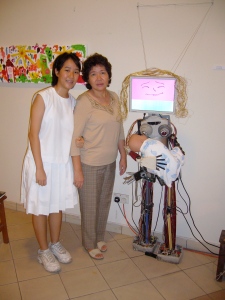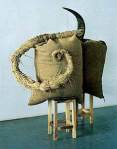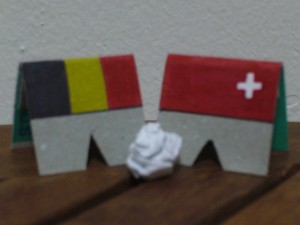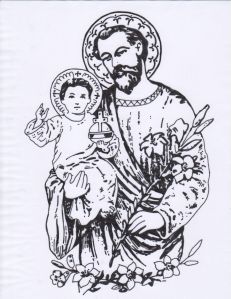Question 2.
Liu Kang, Seated Model (Figure 2a) 1953, Oil on canvas
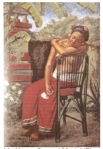
Figure 2a

Figure 2b
Hendra Gunawan Bandung as a Sea of Fire (Figure 2b)
1972, Oil on canvas, 117 x 197.5cm, Collection Ir Ciputra Foundation
(a) Describe the subject matter of these paintings.
In Liu Kang’s “Seated Model”, there is a full body portrait of a semi-nude Balinese woman, and it is the main focus of the entire painting. The woman is bare on top, but wears a long, baggy pair of dull red pants until her ankles, and a white band secures it. She sits on a black rattan chair with her head resting on her left arm, and seems to be very calm and peaceful with her eyes closed. She is most probably taking a break now. She wears white beady earrings on both ears, and there are flowers on her hair. In her right hand, she holds a few white flowers that seem to have been taken from the bush beside her. Her body shape is also well kept, and she appears fit.
However, Hendra Gunawan’s “Bandung as a Sea of Fire” is vastly different compared to “Seated Model”. It depicts an exodus of refugees from a fiery war zone, the result of anti-communist massacre of the 1960s. In the foreground, a man lays on the ground with his limbs twisted in awkward positions. His right hand is pressing onto what seems to be a wound, on his chest, and his eyes are looking up as if in great pain and on the brink of death. Behind him, a woman lay on the floor, and her hands and face all seem to be covered in blood, and she appears to be crushed under some debris. In the middleground, man and woman are seen fleeing with their belongings and children. While in the background, black smoke raises into the air as fire consumes everything in its way, and people flee from the scene. “Bandung as a Sea of Fire” portrays death, destruction, and sufferings of the humankind, and people are seen fighting for their own survival, and that of their loved ones.
(b) Analyse and interpret the artists’ intentions.
In “Seated Model”, Liu Kang seems to be portraying a sense of calmness and peace with the use pf warm colours that blend harmoniously with each other. Earthly colours are mainly used for the foreground, while green is used for the background. He is trying to portray the simple life of the villagers in Bali, and a life of no worries as seen by the woman who is simply resting in the outdoors with a slight smile on her face. The flower in her hands also gives a sense of friendliness and warmth, while suggesting innocence and peace at the same time. Also, as interpretated by her relatively dark skin colour and muscular arms, life is not necessarily easy for the woman. And she may be doing manual jobs. But despite a tough life, she appears happy and satisfied, contented with her lot, and not greedy for more. This shows a contrast between the competitive life and hectic lifestyles of the urban city areas. People in these rural areas take their time to do things, and enjoy life as it is. Furthermore, the blue sky, and calming colour of the trees in the background give a safe and soothing effect. The green that fills up much of the remaining space gives the painting a calm and relaxing look, which is all part of the impression that Liu Kang is trying to portray.
However, in “Bandung as a Sea of Fire” is entirely different. Hendra Gunawan may be suggesting the cruelty of bloodshed cause by the anti-communist raids. The short and choppy brushstrokes, and the lack of details and blending makes the painting look chaotic and hectic. Everything seems to be in a mess, and everyone is in a rush. The fire in the background also seems to suggest turmoil and chaos, whereby everyone is fleeing for their lives. The colours used are also very intensely warm and striking to give a sense of danger. However, the black background covers the painting in a depressing gloom. Hendra Gunawan seems to be conveying an idea of death and destruction, and sufferings of man.
(c) Discuss the impact the two paintings have on you.
Liu Kang’s “Seated Model” gives me a feeling of peace and rest, and some sort of ideal lifestyle whereby I can be free of worries. This is due to the green colour that provides a sense of stillness, and makes on feel at ease. The calming effect makes one feel sleepy just as the woman in the painting is doing, and the inner peace within the woman is successfully brought out as well. Furthermore, the sweet smile of the woman gives a sense of security and reassurance too. All in all, the feelings evoked by this painting are mostly positive and happy.
However, on the other hand, Hendra Gunawa’s painting evokes s sense of chaos and confusion, probably due to the fast brushstrokes used, and the minimal toning and modeling which was used in the painting. It also makes me feel depressed and worried, and some sort of negative feelings are aroused upon the sight of the man in the foreground. The scenes of fire, destruction and helplessness also evoke a sense of tightness as if one is unable to breath due to the situation in which things are in. The bloody red strikes boldly, and gives a twisted feeling that makes on depressed, sad, and fearful at the same time.
Also, as both paintings are done in Indonesia, I have come to the conclusion that Indonesia probably went through many kinds of situations, from peace and stability to utter turmoil and choas. The comparison of the two paintings has provides further insight on the human spirit, about how humans behave as they go through different experiences in life. We can also experience the futility of life through these paintings, as even though everything may seem fine now, no one knows what the future holds.

